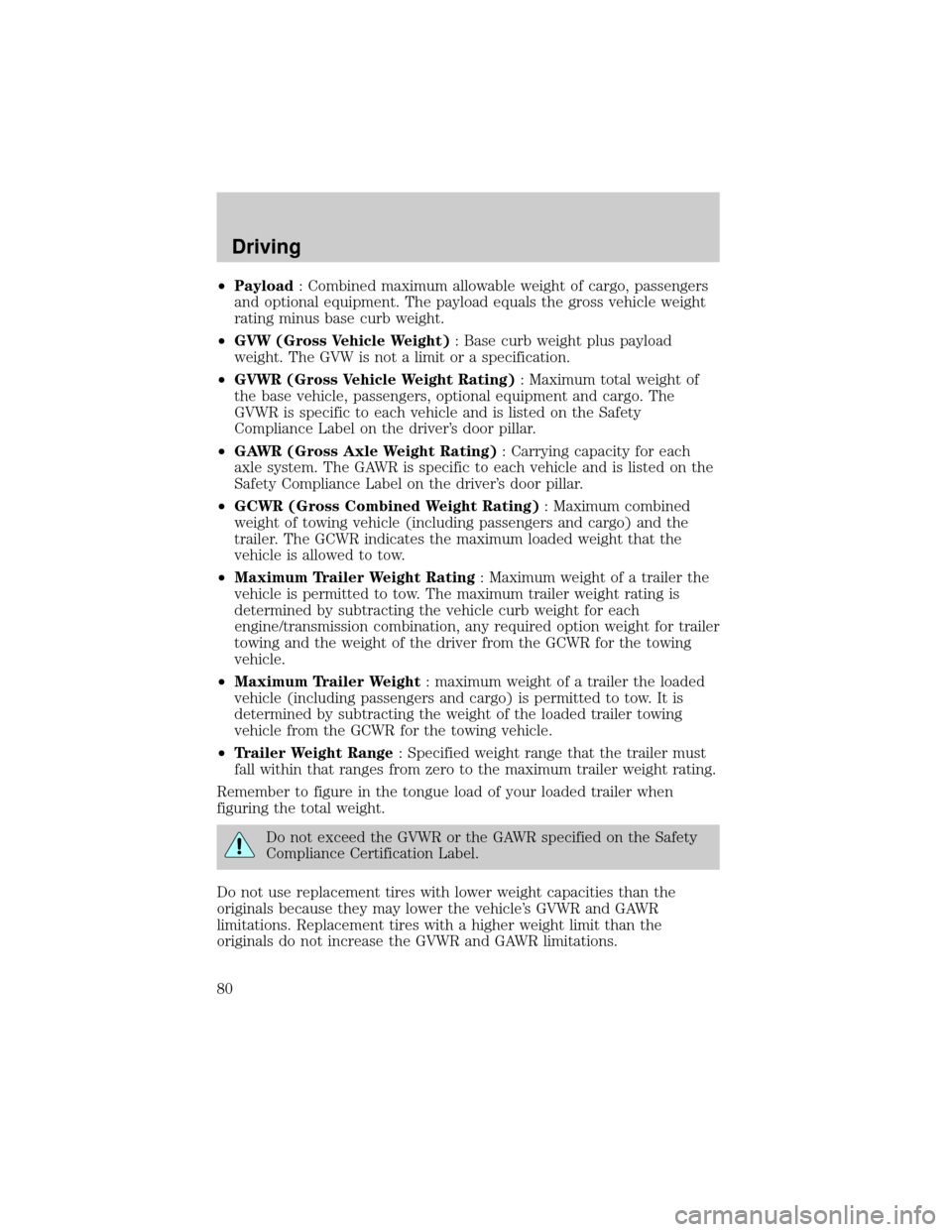1998 FORD RANGER engine
[x] Cancel search: enginePage 80 of 160

²Payload: Combined maximum allowable weight of cargo, passengers
and optional equipment. The payload equals the gross vehicle weight
rating minus base curb weight.
²GVW (Gross Vehicle Weight): Base curb weight plus payload
weight. The GVW is not a limit or a specification.
²GVWR (Gross Vehicle Weight Rating): Maximum total weight of
the base vehicle, passengers, optional equipment and cargo. The
GVWR is specific to each vehicle and is listed on the Safety
Compliance Label on the driver's door pillar.
²GAWR (Gross Axle Weight Rating): Carrying capacity for each
axle system. The GAWR is specific to each vehicle and is listed on the
Safety Compliance Label on the driver's door pillar.
²GCWR (Gross Combined Weight Rating): Maximum combined
weight of towing vehicle (including passengers and cargo) and the
trailer. The GCWR indicates the maximum loaded weight that the
vehicle is allowed to tow.
²Maximum Trailer Weight Rating: Maximum weight of a trailer the
vehicle is permitted to tow. The maximum trailer weight rating is
determined by subtracting the vehicle curb weight for each
engine/transmission combination, any required option weight for trailer
towing and the weight of the driver from the GCWR for the towing
vehicle.
²Maximum Trailer Weight: maximum weight of a trailer the loaded
vehicle (including passengers and cargo) is permitted to tow. It is
determined by subtracting the weight of the loaded trailer towing
vehicle from the GCWR for the towing vehicle.
²Trailer Weight Range: Specified weight range that the trailer must
fall within that ranges from zero to the maximum trailer weight rating.
Remember to figure in the tongue load of your loaded trailer when
figuring the total weight.
Do not exceed the GVWR or the GAWR specified on the Safety
Compliance Certification Label.
Do not use replacement tires with lower weight capacities than the
originals because they may lower the vehicle's GVWR and GAWR
limitations. Replacement tires with a higher weight limit than the
originals do not increase the GVWR and GAWR limitations.
Driving
80
Page 81 of 160

Calculating the load your vehicle can carry/tow
1. Use the Safety Compliance Certification Label to find the axle code
number and engine type for your vehicle.
2. Use the appropriate maximum gross combined weight rating (GCWR)
chart to find the maximum GCWR for your type engine and rear axle
ratio.
3. Weigh your vehicle as you customarily operate the vehicle without
cargo. To obtain correct weights, try taking your vehicle to a shipping
company or an inspection station for trucks.
4. Subtract your loaded vehicle weight from the maximum GCWR on the
following charts. This is the maximum trailer weight your vehicle can tow
and must fall below the maximum shown under maximum trailer weight
on the chart.
DRIVING THROUGH WATER
Do not drive quickly through standing water, especially if the depth is
unknown. Traction or brake capability may be limited and if the ignition
system gets wet, your engine may stall. Water may also enter your
engine's air intake and severely damage your engine.
If driving through deep or standing water is unavoidable, proceed very
slowly. Never drive through water that is higher than the bottom of the
hubs (truck)/wheel rims (car).
Once through the water, always try the brakes. Wet brakes do not stop
the vehicle as effectively as dry brakes. Drying can be improved by
moving your vehicle slowly while applying light pressure on the brake
pedal.
TRAILER TOWING
Your vehicle may tow a class I, II or III trailer provided the maximum
trailer weight is less than or equal to the maximum trailer weight listed
for your engine and rear axle ratio on the following charts.
Your vehicle's load capacity is designated by weight, not by volume, so
you cannot necessarily use all available space when loading a vehicle.
Towing a trailer places an additional load on your vehicle's engine,
transmission, axle, brakes, tires and suspension. Inspect these
components carefully after any towing operation.
Driving
81
Page 82 of 160

Trailer towing table (4x2 manual transmission)
Engine Rear
axle
ratioMaximum
GCWR-kg
(lbs.)Maximum
trailer
weight-kg (lbs.)
(0-maximum)Maximum frontal
area of trailer-m
2
(ft2)
Regular Cab 4x2
2.5L 3.45 Not recommended for trailer towing
2.5L 3.73 2 177
(4 800)0-717
(0-1 580)Equal to frontal
area of base vehicle
3.0L 3.45 2 267
(5 000)0-789
(0-1 740)Equal to frontal
area of base vehicle
3.0L 3.73 2 721
(6 000)0-1 225
(0-2 700)4.64 (50)
4.0L 3.08 2 267
(5 000)0-753
(0-1 660)Equal to frontal
area of base vehicle
4.0L 3.55 3 175 (7 000) 0-1 651 (0-3 640) 4.64 (50)
Regular Cab 4x2 (Splash or Special Suspension)
2.5L 3.73 2 177
(4 800)0-680
(0-1 500)Equal to frontal
area of base vehicle
3.0L 3.73 2 449
(5 400)0-907
(0-2 000)*Equal to frontal
area of base vehicle
4.0L 3.08 2 267
(5 000)0-717
(0-1 580)Equal to frontal
area of base vehicle
4.0L 3.55 2 495
(5 500)0-907
(0-2 000)*Equal to frontal
area of base vehicle
SuperCab 4x2
2.5L 3.73 2 177
(4 800)0-626
(0-1 380)Equal to frontal
area of base vehicle
3.0L 3.45 2 267
(5 000)0-698
(0-1 540)Equal to frontal
area of base vehicle
3.0L 3.73 2 271 (6 000) 0-1 133 (0-2 500) 4.64 (50)
4.0L 3.08 2 267
(5 000)0-635
(0-1 400)Equal to frontal
area of base vehicle
4.0L 3.55 3 175 (7 000) 0-1 542 (0-3 400) 4.64 (50)
Driving
82
Page 83 of 160

Trailer towing table (4x2 manual transmission)
SuperCab 4x2 (Splash or Special Suspension)
3.0L 3.73 2 540
(5 600)0-907
(0-2 000)*Equal to frontal
area of base vehicle
4.0L 3.08 2 267
(5 000)0-635
(0-1 400)Equal to frontal
area of base vehicle
4.0L 3.55 2 540
(5 600)0-907
(0-2 000)*Equal to frontal
area of base vehicle
*Optional payload is not available on 4x2 Splash or Special Suspension,
therefore maximum trailer weight is 907 kg. (2 000 lbs.).
For high altitude operation, reduce GCW by 2% per 300 meters
(1 000 ft.) elevation.
For definition of terms used in this table seeVehicle Loadingearlier
in this chapter.
To determine maximum trailer weight designed for your particular
vehicle, seeCalculating the loadearlier in this chapter.
Maximum trailer weight is shown. The combined weight of the
completed towing vehicle (including hitch, passengers and cargo) and
the loaded trailer must not exceed the Gross Combined Weight Rating
(GCWR).
Trailer tow table (4x4 manual transmission)
Engine Rear
axle
ratioMaximum
GCWR-kg
(lbs.)Maximum
trailer
weight-kg (lbs.)Maximum
frontal area of
trailer-m
2(ft2)
Regular Cab
3.0L 3.73 2 721 (6 000) 0-1 080 (0-2 380) Equal to frontal
area of base
vehicle.
4.0L 3.27 2 721 (6 000) 0-907 (0-2 000) Equal to frontal
area of base
vehicle.
4.0L 3.73 3 175 (7 000) 0-1 515 (0-3 340) Equal to frontal
area of base
vehicle.
Driving
83
Page 84 of 160

Trailer tow table (4x4 manual transmission)
Regular Cab (Splash)
3.0L 3.73 2 721 (6 000) 0-1 070 (0-2 360) 4.64 (50)
4.0L 3.27 2 721 (6 000) 0-907 (0-2 000) 4.64 (50)
4.0L 3.73 3 175 (7 000) 0-1 497 (0-3 300) 4.64 (50)
SuperCab
3.0L 3.73 2 721 (6 000) 0-1 007 (0-2 220) 4.64 (50)
4.0L 3.27 2 721 (6 000) 0-907 (0-2 000) 4.64 (50)
4.0L 3.73 3 175 (7 000) 0-1 442 (0-3 180) 4.64 (50)
SuperCab (Splash)
3.0L 3.73 2 721 (6 000) 0-998 (0-2 200) 4.64 (50)
4.0L 3.27 2 721 (6 000) 0-907 (0-2 000) 4.64 (50)
4.0L 3.73 3 175 (7 000) 0-1 424 (0-3 140) 4.64 (50)
For high altitude operation, reduce GCW by 2% per 300 meters
(1 000 ft.) of elevation.
For definition of terms used in this table, seeVehicle loadingearlier
in this chapter.
To determine maximum trailer weight designed for your vehicle, see
Calculating the loadearlier in this chapter.
Maximum trailer weight is shown. The combined weight of the
completed towing vehicle (including hitch, passengers and cargo) and
the loaded trailer must not exceed the Gross Combined Weight Rating
(GCWR).
Trailer towing table (4x2 automatic transmission)
Engine Rear
axle
ratioMaximum
GCWR-kg
(lbs.)Maximum trailer
weight-kg (lbs.)
(0-maximum)Maximum frontal
area of trailer-m
2
(ft2)
Regular Cab 4x2
2.5L 4.10 2 494 (5 500) 0-1 007 (2 220) Equal to frontal
area of base vehicle
3.0L 3.45 3 175 (7 000) 0-1 660 (0-3 660) 4.64 (50)
3.0L 3.73 3 401 (7 500) 0-1 814 (0-4 000) 4.64 (50)
4.0L 3.08 2 721 (6 000) 0-1 179 (0-2 600) 4.64 (50)
4.0L 3.55 4 309 (9 500) 0-2 721 (0-6 000) 4.64 (50)
Driving
84
Page 86 of 160

Trailer tow table (4x4 automatic transmission)
Engine Rear
axle
ratioMaximum
GCWR-kg
(lbs.)Maximum
trailer
weight-kg (lbs.)Maximum
frontal area of
trailer-m
2(ft2)
Regular Cab
3.0L 3.73 3 401 (7 500) 0-1 741 (0-3 840) 4.64 (50)
3.0L 4.10 3 628 (8 000) 0-1 969 (0-4 340) 4.64 (50)
4.0L 3.27 3 401 (7 500) 0-1 724 (0-3 800) 4.64 (50)
4.0L 3.73 4 309 (9 500) 0-2 631 (0-5 800) 4.64 (50)
Regular Cab (Splash)
3.0L 3.73 3 401 (7 500) 0-1 733 (0-3 820) 4.64 (50)
3.0L 4.10 3 628 (8 000) 0-1 960 (0-4 320) 4.64 (50)
4.0L 3.27 3 401 (7 500) 0-1 706 (0-3 760) 4.64 (50)
4.0L 3.73 4 309 (9 500) 0-2 613 (0-5 760) 4.64 (50)
SuperCab
3.0L 3.73 3 401 (7 500) 0-1 669 (0-3 680) 4.64 (50)
3.0L 4.10 3 628 (8 000) 0-1 896 (0-4 180) 4.64 (50)
4.0L 3.27 3 401 (7 500) 0-1 651 (3 640) 4.64 (50)
4.0L 3.73 4 309 (9 500) 0-2 558 (0-5 640) 4.64 (50)
SuperCab (Splash)
3.0L 3.73 3 401 (7 500) 0-1 660 (0-3 660) 4.64 (50)
3.0L 4.10 3 628 (8 000) 0-1 887 (0-4 160) 4.64 (50)
4.0L 3.27 3 401 (7 500) 0-1 633 (0-3 600) 4.64 (50)
4.0L 3.73 4 309 (9 500) 0-2 540 (0-5 600) 4.64 (50)
For high altitude operation, reduce GCW by 2% per 300 meters
(1 000 ft.) of elevation.
For definition of terms used in this table, seeVehicle loadingearlier
in this chapter.
To determine maximum trailer weight designed for your vehicle, see
Calculating the loadearlier in this chapter.
Maximum trailer weight is shown. The combined weight of the
completed towing vehicle (including hitch, passengers and cargo) and
the loaded trailer must not exceed the Gross Combined Weight Rating
(GCWR).
Driving
86
Page 87 of 160

Do not exceed the GVWR or the GAWR specified on the Safety
Compliance Certification Label.
Towing trailers beyond the maximum recommended gross trailer
weight could result in engine damage, transmission/axle damage,
structural damage, loss of control, and personal injury.
Preparing to tow
Use the proper equipment for towing a trailer, and make sure it is
properly attached to your vehicle. See your dealer or a reliable trailer
dealer if you require assistance.
Hitches
For towing trailers up to 907 kg (2 000 lb), use a weight carrying hitch
and ball which uniformly distributes the trailer tongue loads through the
underbody structure. Use a frame-mounted weight distrubuting hitch for
trailers over 907 kg (2 000 lb).
Do not install a single or multi-clamp type bumper hitch, or a hitch
which attaches to the axle. Underbody mounted hitches are acceptable if
they are installed properly. Follow the towing instructions of a reputable
rental agency.
Whenever a trailer hitch and hardware are removed, make sure all
mounting holes in the underbody are properly sealed to prevent noxious
gases or water from entering.
Safety chains
Always connect the trailer's safety chains to the vehicle. To connect the
trailer's safety chains, cross the chains under the trailer tongue and allow
slack for turning corners.
If you use a rental trailer, follow the instructions that the rental agency
gives to you.
Trailer brakes
Electric brakes and manual, automatic or surge-type brakes are safe if
installed properly and adjusted to the manufacturer's specifications. The
trailer brakes must meet local and Federal regulations.
Driving
87
Page 89 of 160

Trailer towing tips
²Practice turning, stopping and backing up in an area before starting on
a trip to get the feel of the vehicle trailer combination. When turning,
make wider turns so the trailer wheels will clear curbs and other
obstacles.
²Allow more distance for stopping with a trailer attached.
²The trailer tongue weight should be 10±15% of the loaded trailer
weight.
²After you have traveled 80 km (50 miles), thoroughly check your
hitch, electrical connections and trailer wheel lug nuts.
²When stopped in traffic for long periods of time in hot weather, place
the gearshift in P (Park) (automatic transmissions) or 1 (First)
(manual transmissions) and increase idle speed. This aids engine
cooling and air conditioner efficiency.
²Vehicles with trailers should not be parked on a grade. If you must
park on a grade, place wheel chocks under the trailer's wheels.
Launching or retrieving a boat
When backing down a ramp during boat launching or retrieval,
²Do not allow the static water level to rise above the bottom edge of
the rear bumper and
²Do not allow waves to break higher than 15 cm (six inches) above the
bottom edge of the rear bumper.
Exceeding these limits may allow water to enter critical vehicle
components, adversely affecting driveability, emissions and reliability.
If the rear axle is submerged in water, the rear axle lubricant should be
changed. Axle lubricant quantities are not to be checked unless a leak is
suspected.
Recreational towing (all wheels on the ground)
Follow these guidelines for your specific powertrain combination to tow
your vehicle with all four wheels on the ground (such as behind a
recreational vehicle).
These guidelines are designed to ensure that your transmission is not
damaged due to insufficient lubrication.
Driving
89